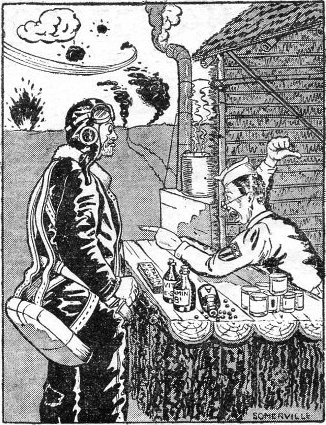FRANCE - "The American soldier is a gallant and brave man." So spoke Gen. Sir Bernard Montgomery, commander of the invasion ground forces that are hammering the Nazis in Normandy. Usually reticent Montgomery painted this picture: All of the beaches were held by secondary German coastal divisions except where the Americans landed . . . Here was a very good Nazi field division . . . The American troops did absolutely magnificently . . . Today these troops are about 10 miles inland. "It was very good, indeed. For a time it looked like a very unpleasant situation." There are no longer any gaps between the British and the Americans . . . The battle of the beaches has been won. "That is very, very good." The Germans have been using women snipers . . . Japs, Poles and Italians have been captured fighting with the Nazis . . . The Japs were fighting as regulars . . . Over 10,000 prisoners have been captured. "I was with the Americans yesterday. They were in tremendous form." (Dispatches said American losses on the beach described by Montgomery were heavy).



VOL. II NO. 40 REG NO. L5015 DELHI, THURSDAY JUNE 15, 1944.
|
Stilwell Closes Escape Routes From Kamaing
NORTHERN BURMA - With Kamaing surrounded and under artillery fire, with Japanese resistance broken in all of the Mogaung Valley north of Kamaing and many villages captured, and with troops making slow but satisfactory progress against the deeply-entrenched Japs in Myitkyina, troops under Lt. Gen. Joseph W. Stilwell continue to paint a drab picture of war for the opposing forces in Burma.
All escapeways from Kamaing have now been closed by Stilwell forces, which have moved in from several directions to completely encircle the town. Columns have approached to within a mile from the northwest and northeast and the town is now under heavy fire from Chinese artillery. Besieging forces have been strengthened.
TAKE JAP EQUIPMENT
In the Mogaung advance, Allied forces captured considerable equipment and supplies which the Japanese abandoned in their disorderly withdrawal before the onrushing Stilwell columns. Included in the equipment were many pieces of artillery.
More than 200 Japanese were killed in the engagements west of Lachi Ga and Sakan. Near Nanyaseik, 10 miles northwest of Kamaing, other Chinese troops inflicted heavy casualties on the enemy and seized vehicles and supplies. Chakrao, six miles west of Kamaing, has been occupied. East of Tumbonghka, other Chinese troops captured Kadon, where more than 100 Jap dead were counted.
MYITKYINA RING TIGHTENS
General Stilwell's forces tightened their ring of steel around the shattered city of Myitkyina, but the Japs continued to resist from their strongly-entrenched pillboxes despite the fact flame throwers, mortars and artillery are being used against them. The encircled Japs' artillery fire continues strong to impede progress of the attacking forces. Advances are measured in yards, so firmly and strongly entrenched are the Japanese, but the fighting has produced at least 200 dead Nipponese during the last several days. The Rifle Range, a Nip stronghold in the northwest Myitkyina sector, fell to Chinese troops in mid-week. Merrill's Raiders inflicted heavy casualties on the Japs north of Radhapur.
South of Mogaung, Allied troops have occupied the village of Pin Hmi, inflicting heavy casualties and capturing supplies and large dumps of ammunition - about 200 wagon loads - when the enemy broke and fled.
Chindit troops now occupy most of the hill features east of Mogaung.
SALWEEN CHINESE WIN LUNGLING BY ASSAULT
SALWEEN FRONT - Storming the walled city in the face of suicidal Japanese resistance, the Chinese Expeditionary Force accompanied by an American liaison group under Brig. Gen. Frank Dorn, has scored its greatest success in the Salween offensive by capturing Lungling despite the fact inclement weather prevented air support.
Practically the entire Japanese garrison was destroyed as Chinese troops cut off enemy forces in Tengchung from reinforcements and supplies from their southern Burma bases by taking this strategically important city on the old Burma Road 22 miles west of the Salween River.
NINE-MILE PURSUIT
Chinese troops fell upon Lungling from several directions. They disregarded Jap fire from a heavily fortified position on Monglingpo Hill, which controlled the southern and eastern parts of the city. The hill changed hands nine times before its final capture.
Only a small group of Japanese was able to escape the Chinese assault and the majority of them were killed during a nine-mile pursuit west of the city.
The westward drive of the Chinese Expeditionary Forces is a part of a pincers movement in conjunction with the drive by Lt. Gen. Joseph Stilwell's troops in Burma, which has as its objective the cutting off of the Japs in North Burma to permit the joining of the Ledo Road and the northern section of the old Burma Road.
In the drive down the Burma Road on Lungling, troops under Maj. Gen. Sung Hsi-Lien, first captured
|
On northern sectors of the Salween front bitter fighting continued, but the town of Chiatou has fallen and Kaitou is also in Chinese hands. The Japs are holding out at Nanchaipungtung and are putting up stubborn resistance at Peicsaicungtung.
Fighting in the Shweli River Valley leading south to Tengchung was marked by gains made near Watien, where the Chinese pushed westward.
Despite big losses when the Japs threw in heavy reinforcement, Marshal Wei Li Huang and Chief of Staff Gen Hsiao Li Hsu report steady progress by Chinese troops on wide fronts that confused the enemy and which may overwhelm him before the monsoon drenches the area. The Chinese are employing the Japs' own tactics of bypass and isolation.
The 14th Air Force, when the weather permits, assists Chinese ground forces by bombing isolated pockets of Jap resistance. American Y Force engineers have been of great help in ferry operations over the swift currents of the Salween, moving Chinese troop supplies across the muddy stream. U.S. Army Medical Corps mobile hospital units are treating the wounded brought back over slippery trails. Plasma brought from New York by the first Chinese blood bank unit saves the lives of many wounded.
EAC PLANES SMASH BANGKOK IN HEAVIEST BOMBER ASSAULT
EAC HEADQUARTERS - Operations of Maj. Gen. George E. Stratemeyer's Eastern Air Command were considerably hampered this week by adverse weather conditions throughout Burma.
In spite of this, however, fighters, fighter-bombers and dive-bombers of Sir John Baldwin's Tactical Air Force continued to give close and effective support to Allied ground troops, attacking Japanese in the Imphal-Kohima and Myitkyina areas. On June 5, strong forces of heavy bombers of the Strategic Air Force dealt Bangkok its heaviest blow of the war.
On this raid, the city's defenses apparently were caught by surprise as formations of B-24's converged on the target at great height from all directions. A record tonnage of demolition and incendiary bombs were dropped, concentrating on the city's railway shops and freight yards. Anti-aircraft fire was heavy but inaccurate, and the few enemy planes, which rose to intercept, failed to attack the massed formations.
DIRECT HITS
B-25's of the Strategic Air Force scored 18 direct hits on the railroad between Wuntho and Shwebo and strafed two locomotives at Thystybin. During the entire week B-25's attacked the Imphal-Tiddim Road, scoring a considerable number of direct hits and near misses at milestone 87.
P-40's, P-51's and A-36's of the Tactical Air Force, during the week concentrated on providing direct support for Lt. Gen. Joseph W. Stilwell's forces at Myitkyina and continuously earned high praise from the ground troops for the persistence and accuracy of their attacks.
P-51's and A-36's flew sorties from early in the morning until late at night against selected targets in the Myitkyina area, scoring direct hits on gun positions, machine gun nests and petrol dumps.
RAF RAIDS
RAF fighter-bombers and dive-bombers did the same type of work in the Imphal-Kohima sector, bombing and strafing trenches, bunkers and enemy troop concentrations with success.
At week's end, long-range fighters of the Tactical Air Force carried out successful attacks on shipping in the Mandalay area, scoring hits on a 150-foot railway barge and other large vessels.
SEAC Announces Nippon Casualties Mount To 21,650
KANDY - British Imperial troops "have inflicted 21,650 casualties on the Japanese in Burma since Jan. 1," SEAC headquarters announced this week as Jap positions in India and Burma deteriorated rapidly.
British units have driven 24 miles east of Kohima in India.
Japanese counter-attacks at both ends of the Imphal-Kohima road have been repulsed by Allied forces, which inflicted heavy casualties on the desperately-fighting enemy.
The Allies have cleared a road block at Wiswema village, 14 miles south of Kohima, and also met and defeated a Jap tank attack on the Tiddim Road, 20 miles south of Imphal, after the Japs first penetrated the defense line.
|
For seven years the Chinese have seen their homes destroyed and their own loved ones killed by bombs from planes with red circles on their wings. But during the past few months the air has been growing increasingly unhealthy for the Jap raiders and bombers, thanks a lot to the Chinese-American Composite Wing.
In fact, tactics are swiftly changing from defense to offense as these American-trained Chinese pilots and their U.S. buddies are stepping up attacks on military objectives on the ground. And they're looking forward to Destination Tokyo.
Many of the Chinese pilots were first trained at Arizona's Thunderbird Field, while an operational training unit was formed in this theater to issue a steady flow of air and ground crew personnel. The idea grew out of the visit to America of Madame Chiang Kai-Shek, who appealed for air support. The Composite Wing plan was drafted and schools set up.
A major problem was the language barrier - American instructor couldn't speak Chinese, and the willing pupils were slow to react when they heard over the interphone: "Pull her damn nose up."
So the U.S. instructors studied Chinese, until today, it is not surprising to hear one of them say to a Chinese flier after a busy day at the Field: "Jahn woman qui-den lee-ki sudi," which translated into Texas drawl means, "Let's get the hell out of here."
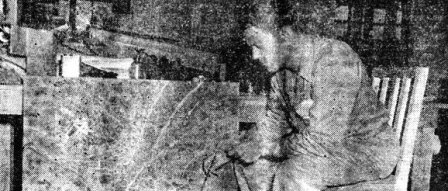 Sgt. George Schoenitch's sand table is an important aid to Chinese-American Composite Wing bombings, for there are few good maps of China and the elements often change terrain.
Sgt. George Schoenitch's sand table is an important aid to Chinese-American Composite Wing bombings, for there are few good maps of China and the elements often change terrain.
|
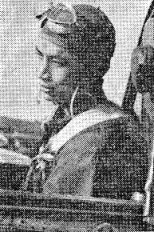 Lt. C. T. Shen flashes a smile as he takes off for a mission.
Lt. C. T. Shen flashes a smile as he takes off for a mission.
|
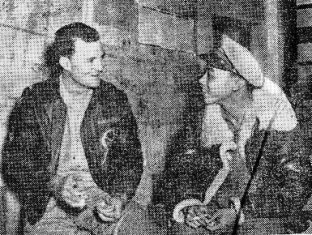 Lt. R. S. Bell and Lt. Y. L. Liu, B-25 pilots, discuss their recent bombing of Formosa, Jap hornet nest in the China Sea.
Lt. R. S. Bell and Lt. Y. L. Liu, B-25 pilots, discuss their recent bombing of Formosa, Jap hornet nest in the China Sea.
|
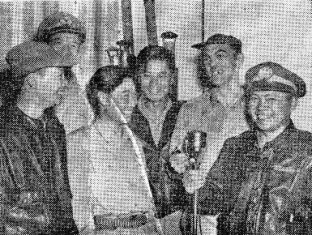 The CBI Radio Team visited an advance base and recorded an all-Chinese program, destined for the Blue Network.
The CBI Radio Team visited an advance base and recorded an all-Chinese program, destined for the Blue Network.
|
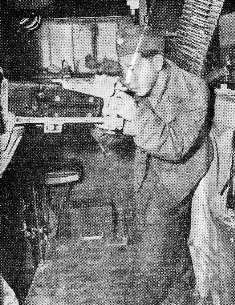 Chu Seng-San, veteran Chinese aerial gunner, practices sighting with caliber 50's in a B-25, of which he is a crew member.
Chu Seng-San, veteran Chinese aerial gunner, practices sighting with caliber 50's in a B-25, of which he is a crew member.
|
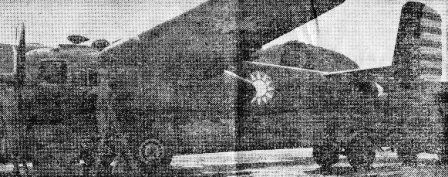 Americans and Chinese work side by side on overhaul repair and installations. The Yank G.I.'s are Sgt. J. F. Soucik, left and S/Sgt. R. T. Fitzgerald. Chinese do comparable tasks.
Americans and Chinese work side by side on overhaul repair and installations. The Yank G.I.'s are Sgt. J. F. Soucik, left and S/Sgt. R. T. Fitzgerald. Chinese do comparable tasks.
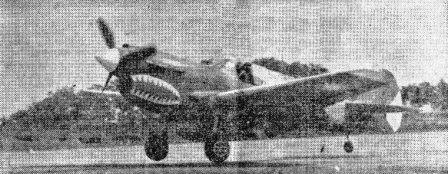 A perfect landing, a la Chinese. That's an American-trained Chinese pilot of the Composite Wing landing his aircraft with skill and aplomb at an advanced fighter and bomber base.
A perfect landing, a la Chinese. That's an American-trained Chinese pilot of the Composite Wing landing his aircraft with skill and aplomb at an advanced fighter and bomber base.
|
Liaison Planes Bomb Ferrys On Irrawaddy
MYITKYINA (Delayed) - The banner headlines of the Myitkyina Bugle (if there was such an animal) could have announced the other day: "DEVASTATING ATTACK ON IRRAWADDY RIVER TRAFFIC."
The story is one of the most unique in the annals of Lt. Gen. Joseph W. Stilwell's Northern Burma campaign, for the bombing was carried out by tiny liaison planes of the Army Observation Corps. These Model T's of the air fly over the battle area, sometimes for three hours at a time, to direct artillery fire, circling at less than 65 miles an hour above Jap positions in order to give range and direction to Allied gun crews.
It's a dangerous job, for because of their slow speed, the saucy little craft offer easy targets to the enemy.
TURNABOUT FAIR PLAY
Turnabout is fair play, so the liaison planes were recently given an opportunity of striking back - by bombing the Japs by hand.
But let T/Sgt. Carl A. Corey, of Stamford, Tex., tell the story:
"We landed at Myitkyina when the Japs were still at one end of the strip. Heavy fighting was still going on. A little later, we were ordered to bomb a ferryboat full of supplies in the Irrawaddy. I took off with an officer and an observation cockpit full of bombs.
'THEN FUN BEGAN'
"We found the ferryboat without difficulty, and then the fun began. I flew low over the target while the officer threw the bombs out, aiming as best he could. We got one direct hit and several near misses."
Artillery observation - and an occasional bombing mission - is only one of the assignments of the Army Observation Corps planes. They are also used for evacuating the wounded, for photo reconnaissance and for newsreel filming.
TRAGEDY STALKS GIFT TO SHANGRI-LA
CHINA - Back in February, Lt. W. J. McDermott, P.I. Officer at the headquarters of a Chinese-American Composite Wing, sent home as a gift to his father, Charles H. McDermott, of Indianapolis, Ind., an antique lounging coat, magnificent in color and embroidery, and of vintage of three generations of mandarins.
Perhaps visualizing the thing gathering barnacles on its long voyage over the seven seas, and certainly not wishing to introduce elephantiasis or some such exotic Oriental disease to Indianapolis via his father, the lieutenant sent strict instructions to have the coat dry cleaned.
Just the other day McDermott received an envelope with an interesting bulge in its midriff. Scenting a present, he tore it open. Inside was the lounging coat, embroidery and all, reduced to a handful of silken threads.
Said the lieutenant ruefully: "At least the cleaning fluid must have been good."
INCLEMENT WEATHER FAILS TO HALT 14TH
14TH A.F. HQ. - Unfavorable weather conditions during most of the week may have put a damper on the Japanese, but not on Maj. Gen. Claire Chennault's 14th Air Force and Chinese-American Composite Wing, which made devastating attacks through heavy cloud formations on the Yellow River sector, the Yangtze River area, installations in Burma, shipping off the South China Coast and important mines and installations in French Indo-China.
Most widespread of the operations came early in the week. While B-25's bombed enemy installations in Burma, smashing at the Lashio bridge, other aircraft strafed cavalry and rivercraft in the Yangtze River area. To the west, three motor launches were shot up, killing 150 Japanese. On a flight from Kwaiyi to Fulinpu, 12 Tojo fighters were met and one Jap plane was probably downed.
GET TWO MORE
In the same area, a formation of P-51's and B-25's were intercepted while attacking Yuankiang. Of the 11 Jap planes, American pilots claimed two confirmed, one probable and four damaged.
Meanwhile, the Chinese-American Composite Wing, supporting Chinese ground troops on the Yellow River front, bombed 13 tanks in the vicinity of Taying. Railroad lines and highways between Hauchang and Csaghsien were also bombed and 10 locomotives were destroyed.
INDO-CHINA HIT
As Tojo's troops were still staggering from these attacks, P-40's hit oil barges and troop concentrations in the eastern sector, near Yuankiang. Shipping, off the Nanpeng islands on the Southeast China coast, was attacked at the same time by B-25's.
Carbide mines in French Indo-China were bombed by two P-40's, seriously damaging the processing building. Several days later, the Yellow River area was again attacked, and B-25's, in a sea sweep off the South China Coast sank a 1,700-ton freighter and seriously damaged a 2,700-ton vessel.
At week's end, weather conditions cleared, and the 14th stepped up the offensive in the Yangtze and Yellow River areas, damaging rail installations and several planes aground. Following this mission, villages north and east of Changsha were heavily hit and over 1,000 enemy troops were killed. Later, Hankow and Wuchang airdromes were bombed by Mitchells.
|
Diplomat Uses Local Labor In Craft Shop
By Cpl. C. M. BUCHANAN
ALONG THE LEDO ROAD - "Necessity became the mother of invention" at this Sub-Depot in Burma when furniture and office equipment were badly needed.
Lt. Col. Robert A. Hirshfield, commanding the Sub-Depot, initiated a move to import native carpenters and weavers. As a result, today a full-fledged crafts shop is operating here in the Hukawng Valley, close to the Ledo Road that General Pick's Engineering troops are building to China.
Working under the same roof, Garos from the hills of Assam, and Nepalese from the province of Nepal are turning out a remarkable volume of chairs, tables, desks, cabinets, filing baskets, woven bamboo stools and special equipment.
Pvt. Wayne R. Helmick, who supervises the shop, is a combination diplomat and foreman. The Nepalese carpenters work in one end of a shed, constructing equipment of wood, while the Garos are confined to the other end, weaving cane and bamboo into intricate designs and forms.
Helmick pointed out that the Nepalese workmen are as highly skilled in their trade as the Garos, but have learned to use American tools such as the saw and plane.
The Nepalese fell trees, split them, shape the timbers with a hand adze and knife. They previously pegged all pieces together with bamboo dowels, but have now been trained to drive nails.
The Garos, on the other hand, go merrily along using only a native knife and deft fingers to weave bulletin boards, chair seats, waste paper baskets and many other items.
"A little candy and cigarettes works wonders," Helmick confided. Neither group understands the other's language and there is no intermingling between natives.
About 75% of the Garos are Christians, while the Nepalese are Hindus. Weekly, the Garos attend services and sing hymns in their native tongue.
"We turn out some specialties, too," Helmick proudly stated, pointing to a six-holer that would have made Chic Sale envious.
TOJO AIDS MORALE China G.I.'s Appreciate Airings
By Lt. MICHAEL ROBBE
CHINA AIR BASE - Guess who's providing top entertainment every day for the boys of the 14th Air Force?
Tojo! And if it were possible, the Yanks would wire him congratulations.
In China, where it's impossible for most radio sets to pick up San Francisco and where London comes in very faintly, the Nips have set up powerful transmitters at nearby Hong Kong and Shanghai, for afternoon and evening broadcasts in English.
Most of the Jap programs are intended for Americans and their Allies in Australia and the Southwest Pacific, but Chinese sets pick them up with ease - just like tuning in WLW from a Cincinnati suburb.
The slant-eyed Sons of Heaven know exactly what the boys want and give out with that solid swing of Harry James, Artie Shaw, Benny Goodman, etc. Many of the records were waxed after Pearl Harbor and where the enemy got them is a mystery. But the airmen don't give a damn. They sound good.
Naturally, Tojo isn't going to give the boys all music. He sandwiches in his commercials - corny propaganda that turns out to be more humor than sense. But the fellows will sit it out because the swing music that will come next sounds darn swell!
Dugouts Prove Invaluable On Jungle Rivers
BURMA - This may be a mechanized war, but G.I.'s in the jungle willingly give their vote of recognition to one of the most ancient modes of transportation - crude native dugouts. The reason: they've seen many of their wounded comrades evacuated in these native-propelled boats from areas where motor transport or airplanes cannot possibly be made available.
The jungle rivers are crowded with these rickety native boats which are helping make evacuation of wounded a fairly quick and fairly comfortable proposition. Even under ideal conditions, getting wounded men out of the jungle and back to base hospitals is a dangerous business - dangerous to the patients and to the men who attend the wounded. Back in the early days of the war the patients were carried by litter or by mule along jungle trails to a point where they could be transferred to jeep or ambulances. It was a long hard way which required many days to traverse. Now the dugouts are making life easier for all.
Native Burmese crews consist of a helmsman, who guides the 40-foot boat with an oar or rudder, and two oarsmen, each of whom manipulates a 15-foot paddle while sitting on the narrow built-up gunwales. These crews are recruited from villages in Allied-occupied Burma and from those natives who walk through the Japanese lines to the Allied side. They're faithful lads, although every now and then, especially around pay day, they hit the AWOL trail in search of a jungle beverage called "palm toddy." But they soon show up again ready for work with a grin and a hangover.
There's only one other thing which ever disrupts the native fleets - the sight of a turtle sunning on a sandbar. That's always a signal for complete confusion throughout the entire convoy. The boats are beached with fierce, vigorous strokes and the crews race to the spot where the turtle was last seen. They dig furiously. Most of the time the turtles escape, but if it is caught some native village is in for the thrill of a turtle feast.
Change 38 Engines In 19 Days
13-MAN CREW DOES HURRY-UP BUSINESS
AIR TRANSPORT COMMAND BASE, STATION 4, INDIA - After completing their thirty-eighth engine change in 19 days, 13 mechanics at this station thought they ought to apply for jobs at Willow Run. Their record is believed to be unequalled in the India-China Wing of the Air Transport Command.
Six of the men were busy "setting up" the engines, while the other seven were "hanging" them. The first group included W/O Ernest E. Creach, Hammon, Okla.; M/Sgt. Edwin H. Brady, Cincinnati, Ohio; T/Sgt. Robert M. Parr, Alexandria, Va.; T/Sgt. William F. Smith, Brooklyn, N.Y.; S/Sgt. Robert L. Campbell, New Brunswick, N.J. and Cpl. Fred C. Knippenberg, Bronx, N.Y.
Those who hung the engines were M/Sgt. Phillip E. Coulson, Euclid, Ohio; T/Sgt. Charles J. Henry, Clayton, Wash.; T/Sgt. Clarence R. Schmidt, Milwaukee, Wis.; S/Sgt. Lucien A. Levesque, Anthony, R.I.; S/Sgt. Karl A. Voss, Kernersville, N.C.; Cpl. Stanley K. Geyer, Hamilton, Ohio, and Cpl. Rodney H. Lane, Gloucester, Mass.
GETTING HOME PROVES DIFFICULT ORDEAL
AFTER BOMBER CREW BAILS OUT IN BURMA
SKULL AND WINGS MEDIUM BOMB SQUADRON - Forced to bail out into the ominous darkness of a recent Burma night while over the craggy and wooded foothills of the Lushai Range, four members of this veteran CBI outfit had an unforgettable experience in finding their way back to civilization, one by one, over a period from two to four days.
The four men, all with considerable combat time under their belts, were Pilot Lt. Dale T. Horney, Engineer-Gunner S/Sgt. Jefferson B. Dishongh, Armorer-Gunner S/Sgt. Lawrence D. Cain and Radio-Gunner S/Sgt. Harold R. Manley.
Participants in a daring and successful low-level moonlight raid on big, vital Sittang Bridge, often called the most important bridge in Asia, they had to hit the silk, fortunately in friendly territory, when their ship ran out of fuel.
Manley and Horney probably had the narrowest escapes from death, Manley when his 'chute almost failed to blossom open and Horney when he landed in the midst of a vast area of dense, vine-like entanglements and undergrowth from which, despite hour after hour of hacking with a parachute knife and crawling about on all fours, he did not emerge into the open until the third day.
Horney went two full days without water. "That was worse than anything," he said. "I had my emergency rations, but along toward the second day I though I was going to die of thirst."
The third day he finally struggled into the open and shortly after, met several hill people, who took him to their village and provided him with water and food. He got his ideas across with improvised sign language. He slept in the village that night on a crude mat and started off the next morning with several Indian guides who took him down a valley which led to a large Tripura settlement. "I checked in at the police station," he said, "and they informed me that the others had been there before, straggling in one at a time. That was good news."
|
From then on, Horney's route was much the same as that of Cain, Dislongh, and Manley, who, appropriately enough, jumped from the ship and found their way back in that order. He journeyed down the Gumti River in a dugout as far as the tongue-twisting Radhakishorepur, where he was met by a jeep that had been driven up the bumpy road from Comilla by a fellow officer, Lt. Henry Theis.
Cain made the Gumti River boat trip by night, the other two by daylight. After reaching Radhakishorepur, Cain met a young Englishman on a hunting trip, Mr. Phil J. DeLauney, who drove him to the headquarters of Brig. Gen. William Old, chief of the Troop Carrier Command. Sishongh, and eventually Manley, made this leg of the journey by rickety civilian bus.
Perhaps the most interesting incident which befell any of the airmen was that of Manley, who was spotted by a search plane on the second day of his long trek.
Manley had just stretched out on a mat on a porch of an Indian hut when he noticed a sarong-clad Indian woman approach. Genuinely startled when she laid down beside him, he told her to "jao." It developed she was the wife of the village mayor, who was making the supreme gesture of hospitality. "I guess he was hurt, maybe insulted, when I declined his offer," Manley grinned.
The jumpers declared that the inhabitants valued the silk from their parachutes more than anything else they could offer. "They just went wild over the stuff," they reported. "Some of those women are going to be quite ritzy now parading around in new sarongs."
Water was the No. 1 problem of the wandering airmen. Dishongh secured his first drink by accidentally cutting a large creeper vine which sprouted forth a crystal-clear content while the others, before reaching villages, purified stream water with iodine and by boiling it ingeniously in a section of bamboo. These sections made good emergency canteens.
The mission opened on an exciting note. While in the target area, Manley silenced an enemy gun position. Shortly after, the shipwas harassed by five enemy planes which made several passes but were reluctant to mix it up at close quarters.
Samaritan
PILOT 'HELPS' NIP LAND SAFELY
Lt. Thomas R. Wilson, 23-year-old fighter bomber pilot, downed a Jap plane the other day, but he'd rather not talk about it for on the same day he escorted a Jap to safety and his buddies are not letting him forget it.
Wilson belongs to a 10th USAAF P-51 Mustang fighter-bomber unit of the 3rd Tactical Air Force, Eastern Air Command. As such, some of his missions have taken him over Rangoon, as escort for bombers of the Strategic Air Force.
One day, while on such a mission, Wilson's formation ran into intense air and ground opposition. Wilson that day knocked down one Jap plane, his second, but in so doing got separated from his formation.
Over the radio he heard one of the Mitchells was hard hit and the crew probably would bail out. In looking around for the Mitchell, Wilson spotted a parachute with a man dangling from the shrouds. They were up 15,000 feet and knowing how well Japs love to riddle defenseless American and British pilots, Wilson decided he'd circle the airman to protect him in case the enemy hove into view.
The intrepid young pilot circled the parachutist until he landed in the Bay of Bengal. Wilson marked the spot on his map and streaked for home. He told his story and expected a rush of the rescue squad for the door. But all he got was a huge horse laugh.
They finally told him no American had bailed out in that vicinity and several pilots had seen a Jap hit the silk, let him go and headed for home.
And Wilson would still rather you didn't mention his victory that day.

MOTHER AND SON The Indian mother wears her infant son Aswing in her sari, tied to her back, all day Or, hung at her side, astraddle her hip, while she Continues picking tea the ancient way. She knives among the bushes as she fills Her basket with fresh leaves of living jade. Bronze hands are busy. Silver bracelets flash In sunlight. Scattered trees lend gentle shade. She may lift her black umbrella while she works It becomes a large dark nimbus in the rain. The barefoot madonna shifts her drowsy boy And looks up, startled at a sudden plane. She wonders on the day he will go forth Where lightning wheels outrun the bullock cart. And magical machines outdo the hands. Tea-picking fills her day; and he, her heart. - By Sgt. F. ELWOOD JONES |
|
CONVERSATION PIECE
Is the gateway to India at Bombay Really as beautiful as they say? Don't rightly know, Ma'am. Did my part Breakin' point in the jungle's heart; blasted the boulders, felled the trees with red muck oozin' around our knees; Carved the guts from the Patkai's side, Dozed our trace, made it clean and wide, Metalled and graded, dug and filled: We had the Ledo Road to build. Well, surely you saw a burning ghat, Fakirs, rope tricks and all of that. Reckon I didn't. But way up ahead I tended the wounded, buried the dead. For I was a Medic, and little we knew, But the smell of sickness all day through, Mosquitoes, leeches, and thick dark mud Where the Chinese spilled their blood After the enemy guns were stilled: We had the Ledo Road to build. |
|
Of course, you found the Taj Mahal, The loveliest building of them all. Can't really say, lady I was stuck Far beyond Shing with a QM truck Monsoon was rugged there, hot and wet, Nothing to do but work and sweat And dry was the dust upon my mouth As steadily big "cats" roared on south, Over this ground where Japs lay killed: We had the Ledo Road to build. You've been gone two years this spring, Didn't you see a single thing? Never saw much but the moon shine on A Burmese temple around Maingkwan, And silver transports high in the sky, Thursday River and the swift Tanai, And Hukawng Valley coming all green, Those are the only sights I've seen. Did our job, though, like God willed: We had the Ledo Road to build. - By. Sgt. SMITH DAWLESS |
India Post Populace Sees First Motor Bike
INDIA PORT - The local populace swallowed its betel nut and gasped in astonishment when Sgt. William Taylor, Hazel Park, Mich., putt-putted up the streets the other day with the first motor bike ever seen in this neck of CBI-land.
Crack welder and mechanic at a supply depot, Taylor constructed the vehicle in three days in his spare time. The wheels were obtained from an ancient P-40 which had seen better days. The gas engine was made from an air compressor. Taylor got his pipes from the top of an old jeep. All the smaller parts were obtained from old, unserviceable vehicles.
With a gas consumption of 75 miles per gallon and a sped of 30 miles per hour, the motor bike enables Taylor to get around with a minimum of gas.
The mobile junk pile has two pedals. The right one controls the gas, the left one the brake.
It's all very simply operated, says Taylor, and the gasps of astonishment alone are worth the effort expended in its construction. - By S/Sgt. HARRY A. SKVIRSKY.
'IT'S AN AWFUL LIE'
SCREAMS OFFICER WHO 'SIGNED' FOR EXTRA TIME IN CBI
By Sgt. SMITH DAWLESS
ASSAM - Along the Ledo Road in the nether regions of Assam lives a Public Relations Officer who has been clasped to the bosom of Mother India for some 18 months. A good fellow, conscientious, hardworking. But he can't forget sunny California, the Little Woman waiting there, anticipating the glorious day when the Golden State Limited will carry him back to her.
One morning last week he walked into the Base Adjutant's office. A pregnant hush fell over the staff. Typewriters ceased clicking, pencils poised as everyone cast reverential and pitying glances in his direction.
The lieutenant felt his head. No, there were no paper mache halos attached thereto. For a delirious moment he envisioned a special order demanding his immediate return to Shangri-La.
"Anything happen?" he inquired with a controlled gesture of nonchalance.
"We just heard you signed the six months extra list," a chorus of shocked male voices answered.
The lieutenant paled, trembled.
"What?" he gasped weakly.
Then it came out. Somehow, somewhere, somebody had accidentally added his name to those craving six months longer of jungle torture.
Needless to say, the lieutenant is feverishly sending cables, writing indignant letters of denial, challenging one and all to produce his signature on the Added Service list. And at night you can find him lurking around the Chinese restaurant mumbling pathetically, "I didn't dood it, I can't dood it. It's all a mistake . . . oh, Hell!"
|
WASHINGTON - (ANS) - Two airmen, under thirty years of age, will be the youngest brigadier generals in the United States Army with Senate approval. The are Col. Clinton D. (Casey) Vincent, 29, of the 14th Air Force, and Col. Richard C. Saunders, 28, of Salt Lake City.
Colonel Vincent, who is now the commanding officer of a Composite Wing, was chief of staff under Maj. Gen. Claire Chennault in the old China Air Task Force. He later led the 14th USAAF Forward Echelon and subsequently was promoted to head of the Tactical Air Force in southern and eastern China and then to his present post.
A year ago, at 28, Vincent was the youngest colonel in the U.S. Army at that time.
Vincent, who has more than 250 hours in the air, was awarded the Legion of Merit in 1943. The award was for outstanding leadership of a small force, which, against numerically superior air strength, succeeded in disrupting enemy communications and routing troop columns. His small force also successfully defended advance air bases many times against strong enemy attacks from the air.
'NON-COMBAT' PILOT AN ACE
OPERATIONS OFFICER BAGS EIGHT NIPS
APO 465 (Dum Dum, India) - Although he is not regarded as a combat member of his P-51 Mustang squadron, 29-yesr-old Capt. James J. England of Jackson, Tenn., is the first American ace in the Third Tactical Air Force now operating against the Japanese in the Indo-Burma sector, it is announced by the 10th Air Force public relations officer.
The answer to that riddle is that England is operations officer of the squadron and makes use of his authority to take his turn on missions along with the regular flying personnel. The result has been eight Japs to his credit. His big bag came one day in March, when three Japs went down before his sights.
|
Pot and Pan Commando Rushes Out With His Specialty
BURMA - To every member of Cochran's American Air Commandos the name of Sweeney will always conjure up a picture of a sandy-haired, freckle-faced grinning Chicago Irishman whose parents tagged him with a front handle of Tom.
Private Sweeney probably will never see his name in the headlines of metropolitan U.S. newspapers, but the members of his outfit thought he was worth a story and this is it. Tom, you see, has plenty of guts, cheerfulness and willingness and plenty of guys will give him credit for 10 men's share, yea even 20, of the Cochran conquests.
There was that quality of Irishness about Sweeney that made him known to everyone, from the major on down, the first day he went into Burma with Cochran's outfit. Soon every light plane pilot coming in from a mission was yelling for Sweeney to rattle up something to eat.
Sweeney made his name, however, when the Jap raids came. He carried with him, in place of his canteen, a bottle of vitamin pills. After every raid, Sweeney made his way through the jungle, offering vitamins to everyone he met. His ear-to-ear grin even made the rugged crowd of light plane pilots like taking their vitamins.
When Sweeney's kitchen was ripped up in one of the raids and his rations burned, Tom was heartbroken. Nevertheless, he poked around the ruins and emerged grinning; he had found several cans of fruit juice. So he hit for the foxholes even before Jap planes had disappeared and doled out fruit juice - and, of course, vitamin pills.
When the other cooks left by light plane, Sweeney remained, despite orders that all messmen be evacuated. And Tom's only worry when a raid was on was that his kitchen might be smashed or that the raid would result in "them damn pilots giving me Hell because chow'll be late."
Genial Sweeney wasn't always the mild, grinning Irishman. They still tell about the night when a tall, bearded pilot, noted for his roughness and reckless courage, inquired nastily when in Hell chow would be served.
Above glasses which he always wore perched low on his nose, Sweeney's pale blue eyes peered at the pilot and they blazed.
"Get your blankety-blank self behind this counter and help out and maybe we'll get the chow out," he shouted.
The pilot stared down at the sweating chow jockey for a second and then meekly, very meekly, walked around the log counter and helped serve. He even opened extra cans of peas and grape jam and was the last man to eat that night.
Sweeney finally was evacuated - against his wishes. We saw him a few weeks later in the kitchen back at H.Q. He was grousing about not making T/5 but he asked us whether we needed any vitamin pills. We couldn't say no to a guy like Sweeney. - S/Sgt. Martin Viscuse.
The C.B.I. Roundup is a weekly newspaper of the United States Army Forces, published by and for the men in China, Burma, and India, from news and pictures supplied by staff members, soldier correspondents, the United Press, OWI, and Army News Service. The Roundup is published Thursday of each week and is printed by The Statesman in New Delhi, India. Editorial matter should be sent directly to Capt. Floyd Walter, Headquarters, U.S.A.F., C.B.I., New Delhi, and should arrive not later than Sunday in order to make that week's issue. Pictures must arrive by Saturday and must be negatives or enlargements. Stories should contain full name and organization of sender.

JUNE 15, 1944
Original issue of C.B.I. Roundup shared by Ruth Canney, widow of CBI veteran John Canney.
Copyright © 2007 Carl Warren Weidenburner
CONVERSATION PIECE
TOP OF PAGE PRINT THIS PAGE ABOUT THIS PAGE SEND COMMENTS
PREVIOUS ISSUE CLOSE THIS WINDOW NEXT ISSUE
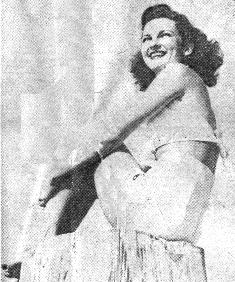 The caption accompanying this picture said Kathleen Turner climbed up on this cypress stump at Winter Haven, Fla.,
in order to get an even sun tan. We can think of better places to sit while getting tanned, but this stump has
its advantages, too. No wolves on the stump.
The caption accompanying this picture said Kathleen Turner climbed up on this cypress stump at Winter Haven, Fla.,
in order to get an even sun tan. We can think of better places to sit while getting tanned, but this stump has
its advantages, too. No wolves on the stump.
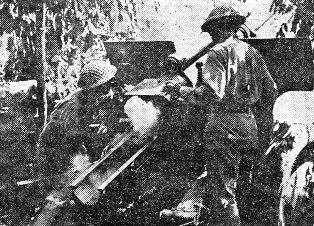 Efficient Chinese guns crews are making life miserable for the Japanese in the fighting in North Burma.
Here's a Chinese 105 mm howitzer gun crew, one of a battery of the 38th Chinese Division which shelled positions
near Warazup. The division was trained in India by the USAF.
Efficient Chinese guns crews are making life miserable for the Japanese in the fighting in North Burma.
Here's a Chinese 105 mm howitzer gun crew, one of a battery of the 38th Chinese Division which shelled positions
near Warazup. The division was trained in India by the USAF.
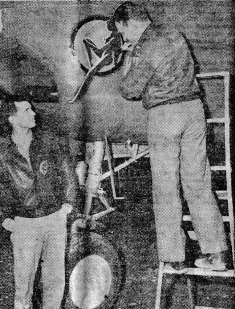 Lt. S. B. Brown models, while Lt. D. J. Keewe paints a most interesting insignia upon the fuselage of his plane.
Lt. S. B. Brown models, while Lt. D. J. Keewe paints a most interesting insignia upon the fuselage of his plane.
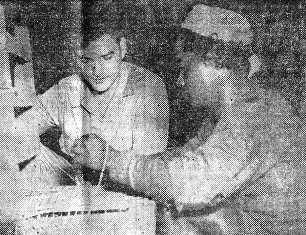 More of a diplomat than a foreman, Pvt. Wayne R. Helmick, of Farmer City, Ill., supervises this craft shop.
Shown with him here is a Garos workman, weaving a chair seat.
More of a diplomat than a foreman, Pvt. Wayne R. Helmick, of Farmer City, Ill., supervises this craft shop.
Shown with him here is a Garos workman, weaving a chair seat.
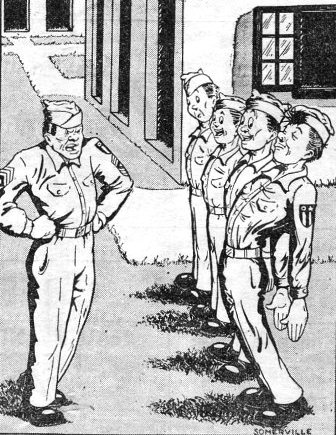 "Wot yer tryin' to do, Louie - open up a second front of yer own ?"
"Wot yer tryin' to do, Louie - open up a second front of yer own ?"
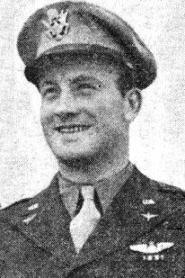 Col. Clinton D. (Casey) Vincent
Col. Clinton D. (Casey) Vincent
